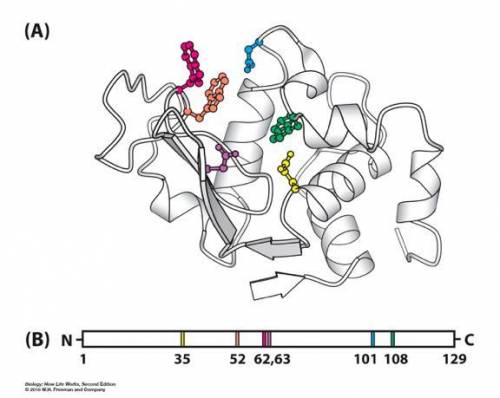
Biology, 23.07.2021 04:20 neolmar9329
1.) Analyzing: The enzyme lysozyme catalyzes the hydrolysis of glycosidic bonds of peptidoglycans, a molecule found in the cell wall of some bacteria. Consider the three-dimensional model of the tertiary structure enzyme lysozyme (A) and a map of the primary structure of lysozyme showing the location of amino acids that participate in binding and catalysis at the active site (B) and answer the following questions.
A.) Lysozyme catalyzes the hydrolysis of glycosidic bonds from peptidoglycans but does not catalyze the hydrolysis of glycosidic bonds in glycogen. Why?
B.) Research has shown that amino acid 35 (yellow), a glutamic acid, an amino acid with a negatively charged side chain, is critical for catalysis. Other studies have found that amino acids 62 (pink) and 63 (purple), both tryptophan, an amino acid with a positively charged side chain, are critical for substrate binding. These amino acids are relatively close together in the active site (see the structure in part A) but are separated by 27 amino acids in the primary structure (see part B). Using what you know about protein structure, explain how amino acids that are separated in the primary structure can come close together in the active site.
C. Use this information and figure 4.2 in your book to answer the following questions: Do you think changing amino acid 35 from glutamic acid, an amino acid with a negatively-charged side chain, to a lysine, an amino acid with a positively-charged side chain will affect the substrate binding, catalysis, both, or neither? Explain answer.)
2.) Applying: Refer to the Lac operon to answer the questions below
A.) How does the presence or absence of different carbon sources affect the expression of genes in the Lac operon? The first row is filled out as an example:
Carbon source Lac repressor Expression of genes in Lac operon
Glucose Bound to DNA Repressed
Glucose + lactose
Lactose
B.) You isolate a mutant that produces the repressor protein but also produces B-galactosidase whether or not lactose is present. In which gene would you expect to find that mutation to be and why?
C.) You isolate a mutant strain with a mutation in lacP (promotor) that prevents RNA polymerase from binding. When would expect this strain to produce B-galactosidase: all the time, only in the presence of lactose, or never? Explain reasoning.
3). Analyzing: Compare regulating gene expression at the level of transcription to regulating gene expression at the level of translation and give an example of each.



Answers: 3
Another question on Biology

Biology, 21.06.2019 15:20
Are substances released into the environment that in excess amounts cause damage
Answers: 1

Biology, 22.06.2019 17:20
If you were given a map of the sensory cortex in the postcentral gyrus of the cerebrum, do you think the map would have more “space” devoted to the regions of the body that have the highest density of sensory receptors, or the regions of the body that have the lowest density of sensory receptors? explain.
Answers: 2

Biology, 23.06.2019 01:00
Which planet descriptor does not apply to jupiter saturn uranus and neptune plz hurry
Answers: 1

Biology, 23.06.2019 03:00
Abird is flying in the air at a 4 m/s. if the mass of the bird is 7kg what is it’s kinetic energy
Answers: 1
You know the right answer?
1.) Analyzing: The enzyme lysozyme catalyzes the hydrolysis of glycosidic bonds of peptidoglycans, a...
Questions












Social Studies, 19.08.2019 21:20




History, 19.08.2019 21:20

Mathematics, 19.08.2019 21:20


Geography, 19.08.2019 21:20

Physics, 19.08.2019 21:20



